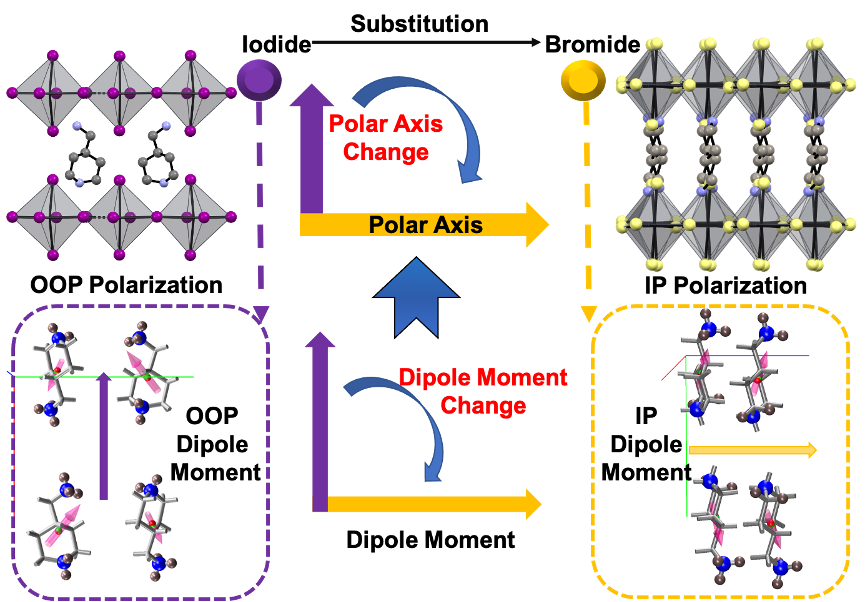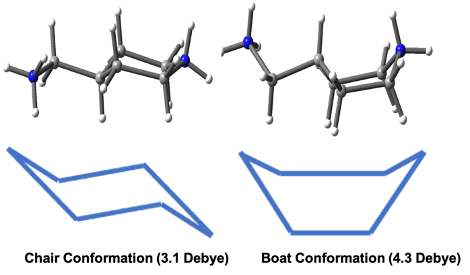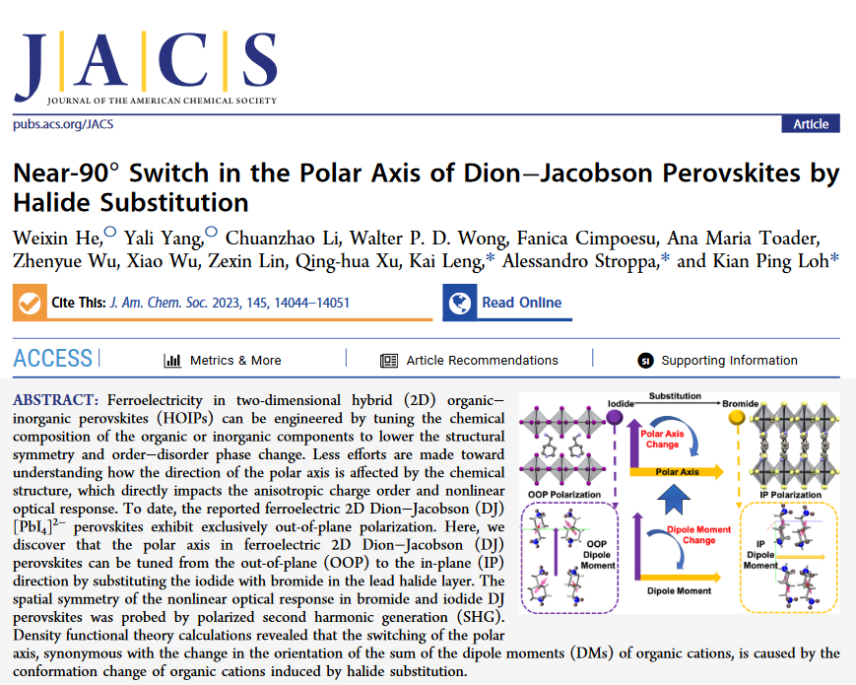An international collaboration, with A. Stroppa (CNR-SPIN), K.P. Loh (NUS), K. Leng (PolyU) as corresponding authors, showed that the polar axis in ferroelectric 2D Dion-Jacobson (DJ) phase hybrid organic-inorganic perovskites (HOIPs) can be switched by almost 90° using halide substitution. In DJ phase (4AMP)PbX4 ferroelectric system (4AMP = 4-(Aminomethyl)piperidine, X= I and Br), by substituting the iodide with bromide element in perovskite layer, the obtained [PbBr4]2- compound presented In-Plane (IP) polar axis, which is in contrast to the all previously reported [PbI4]2- counterparts with Out-of-Plane (OOP) polar axis. (DOI: 10.1021/jacs.3c03921 - https://pubs.acs.org/doi/10.1021/jacs.3c03921?ref=PDF).
The polar axis change is firstly demonstrated by the analysis of ferroelectric-paraelectric phase transition in both compounds. The order-disorder change of 4AMP cations dominates the phase transition, in such a way the order alignment of 4AMP cations along the IP/OOP direction induces the IP/OOP polar configuration.
The linearly polarized second harmonic generation (SHG) presents strong coupling with the polar axis in ferroelectric 2D HOIPs, therefore the polar axis change is subsequently examined by the angle resolved SHG characteristic, where distinguishable polar SHG maps provided a signature of IP and OOP polar configuration in the respective compounds.
At microscopic, an intriguing mechanism has been shown to be associated to IP/OOP polar axis switching, that is the change of molecular conformation of the 4AMP cations induced by the halide substitution. In [PbI4]2- system, due to the larger atomic radius and weaker electronegativity (2.66) of iodine atom, perovskite octahedra provide larger voids and weaker confinement of the 4AMP cations, which allows 4AMP cations to adopt both “boat” and “chair” conformations. Now, an analysis of the electric dipole moments of “boat” and “chair” conformations reveal not only that they possess different dipole moment with 4.3 Debye for “boat” like conformation and 3.1 Debye for “chair” like conformation, but also the dipole directions change significantly. In [PbI4]2- system, however, the antiparallel alignment of “boat” and “chair” like 4AMP cations along the OOP direction results in a net polarization along this direction. For the [PbBr4]2- system, the situation changes dramatically: the perovskite octahedra present smaller voids and stronger confinement of the 4AMP cations, causing all the 4AMP cations to be locked in “chair” conformation. In this case, all the “chair” conformation of the 4AMP cations result the dipoles mainly directed along the IP direction, giving rise to a net polarization. Furthermore, the fundamental difference of ferroelectric behavior (saturated polarization and coercive field) between OOP and IP compounds have also been analyzed based on the molecular level, showing well-fit structural property.


In summary, this work demonstrates that the polar axis can be changed from OOP to IP (near 90º directional change) in ferroelectric 2D DJ perovskites by substituting iodine with bromine in lead halide octahedron. Such tuning is specific to the structure of DJ perovskites because the conformation of organic cations is highly sensitive to the electrostatic interaction between the divalent diamine cations and halide anions. Understanding this principle allows the design of other diamine cations whose conformation can be tuned sensitively by the structure of the inorganic lattice, thus providing a new approach to tune ferroic, optoelectronic or mechanical properties by conformational changes.
Reference: Weixin He, Yali Yang, Chuanzhao Li, Walter P. D. Wong, Fanica Cimpoesu, Ana Maria Toader, Zhenyue Wu, Xiao Wu, Zexin Lin, Qing-hua Xu, Kai Leng*, Alessandro Stroppa*, Kian Ping Loh* Near-90° Switch in the Polar Axis of Dion–Jacobson Perovskites by Halide Substitution, Journal of the American Chemical Society 2023, 145 (25), 14044-14051.
DOI: 10.1021/jacs.3c03921 (https://pubs.acs.org/doi/10.1021/jacs.3c03921?ref=PDF)


